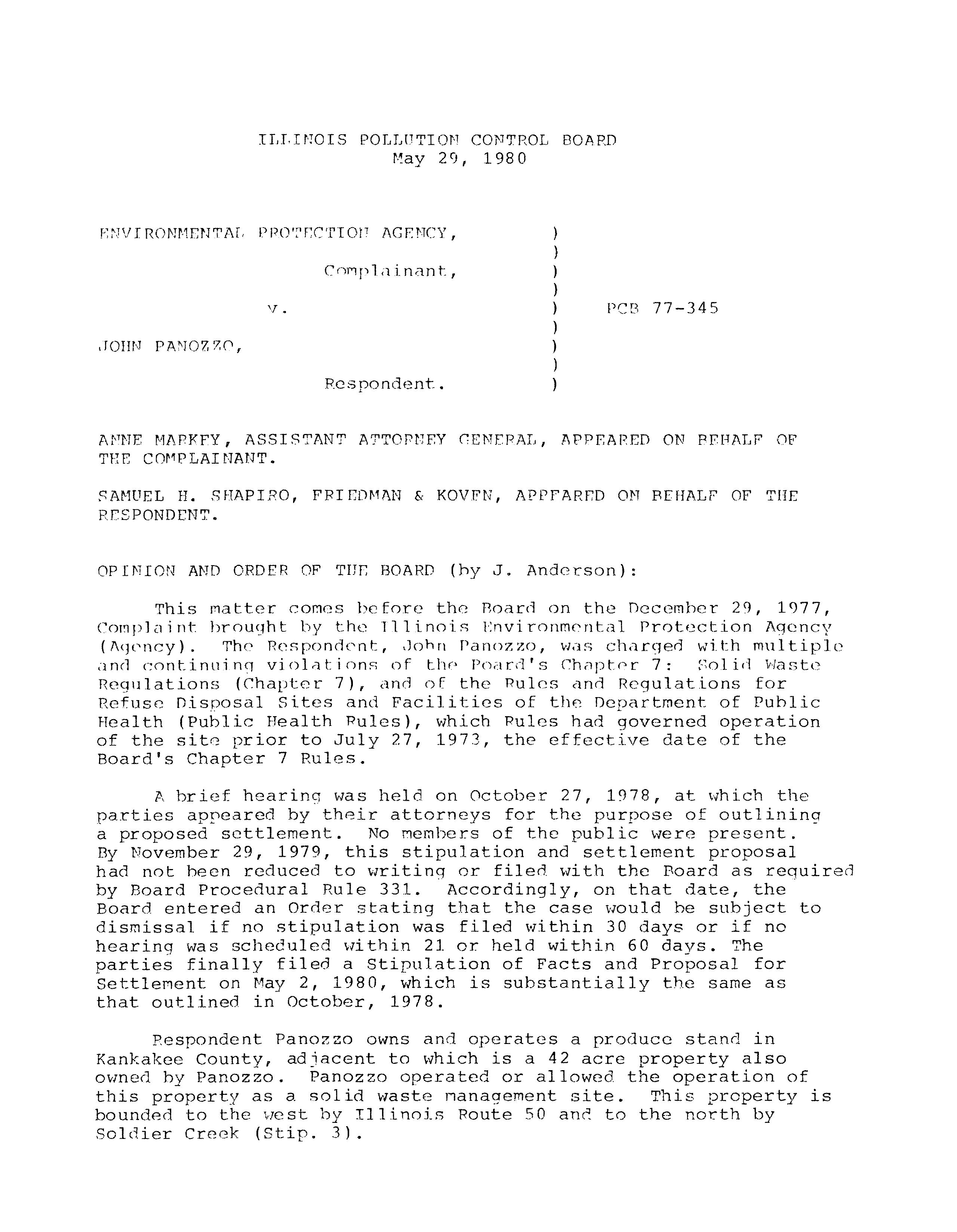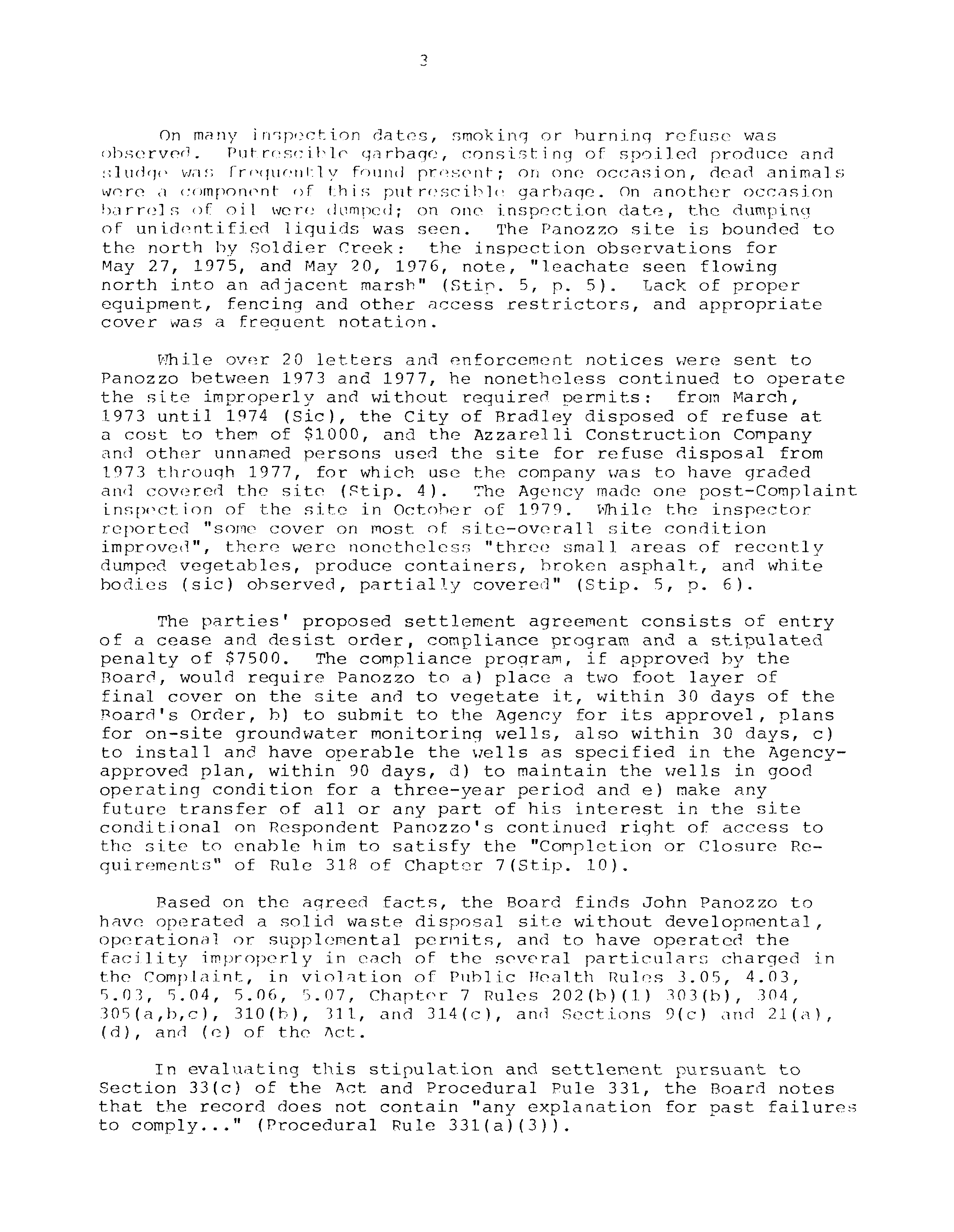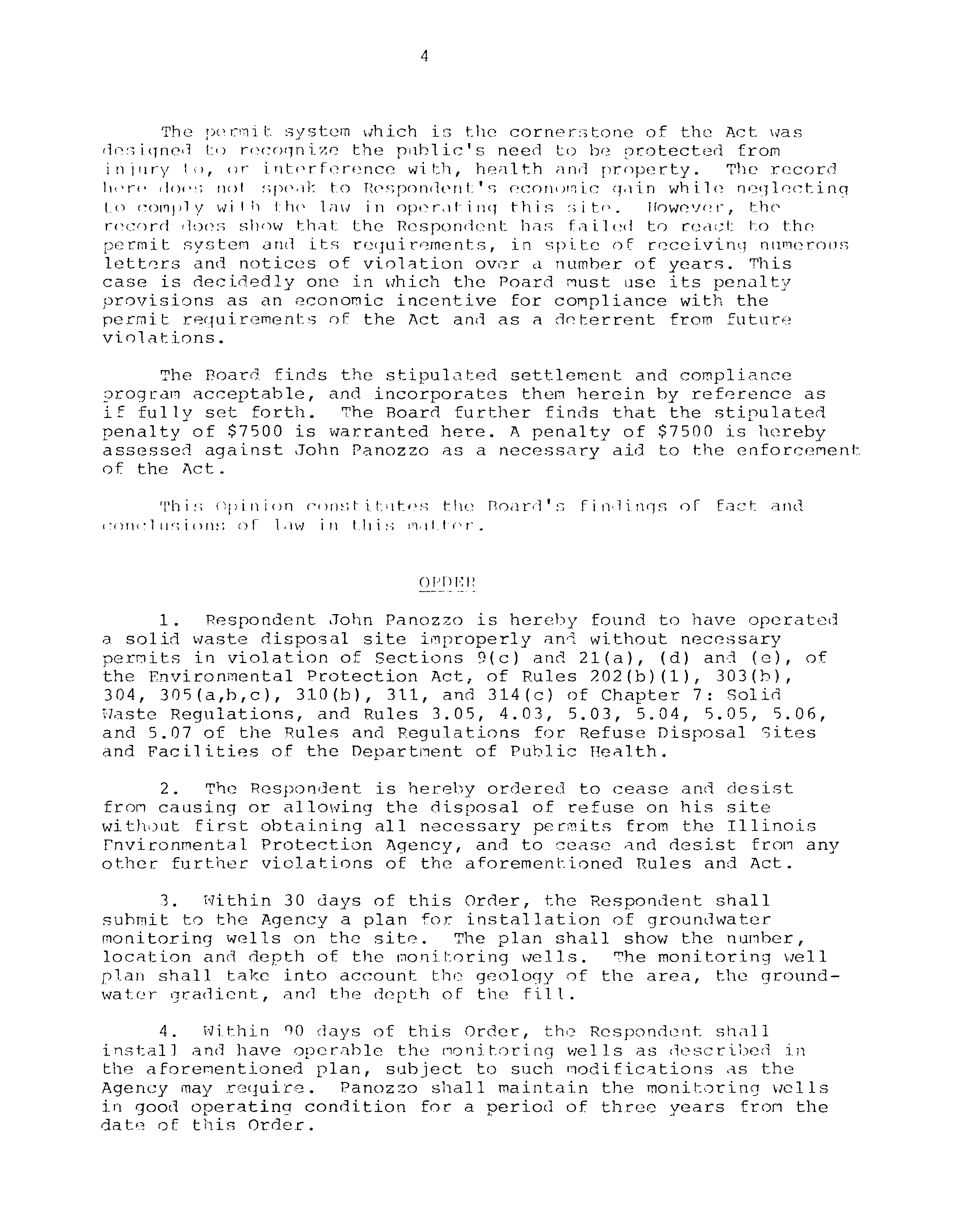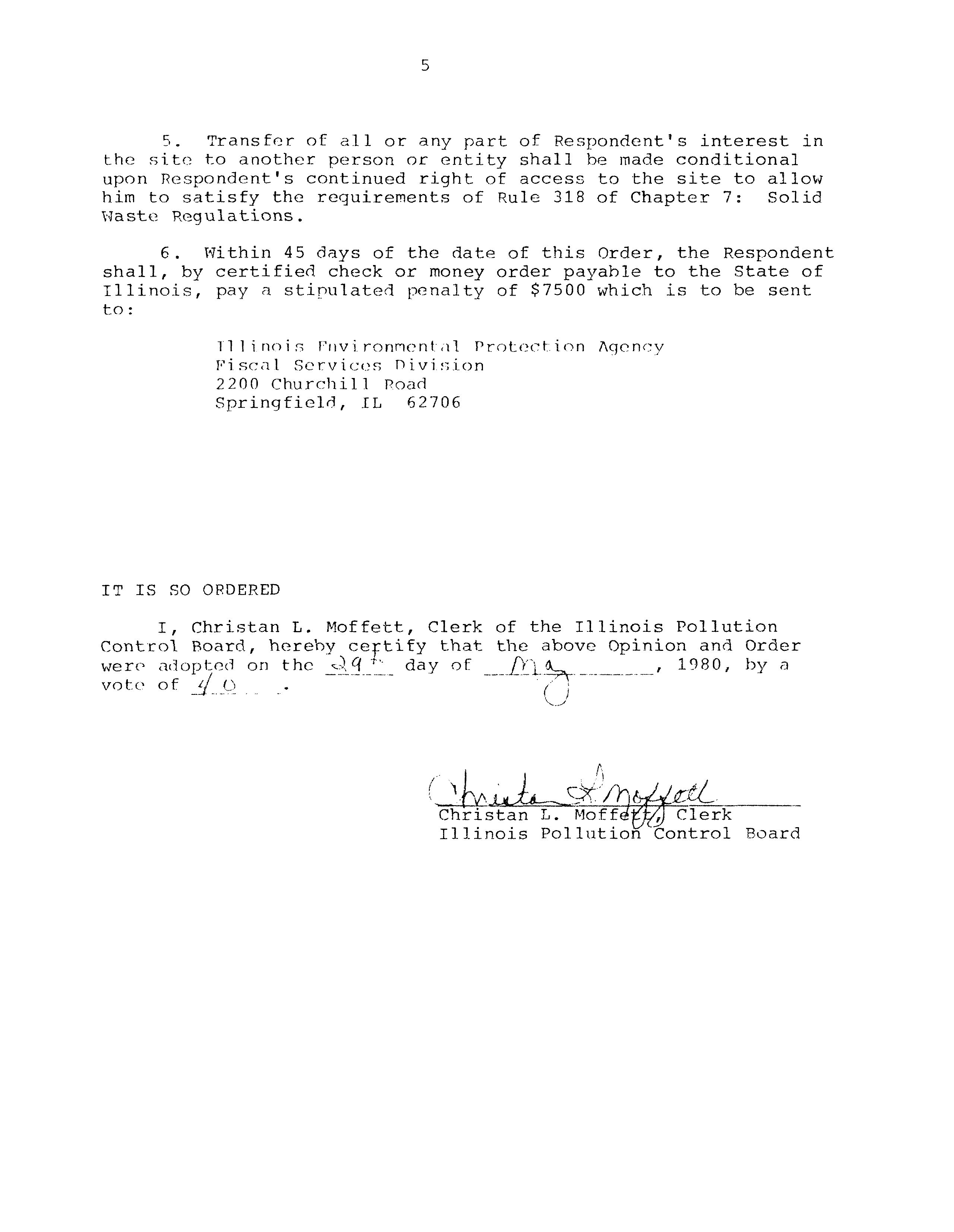ILTItNOIS
POLLUTION
CONTROL
F30?\RD
May
29,
1980
UHVI
RONMENTAr
PPOTCT~ON
AGENCY
,
Cnmplainant,
V.
)
P
77—345
JOHN
PANOZ
ZO,
Respondent.
ANNE
MAPKFY,
ASSISTANT
ATTOPNFY
GENERAL,
1\PPEAPED
ON
PEPALE
OF
THE
COMPLAINANT.
SAMUEL
H.
SFTAPIPO,
FRIEDMAN
&
KOVFN,
APPEARED
ON
BEHALF
OF
TUE
RESPONDENT.
OPINION
AND
ORDER
OF
TUE
BOARD
(by
J,
Anderson):
This
matter
comes
before
the
Hoard
on
the
December
29,
1077,
Cor!lpl
~i
i nt
brouqh
t
by
the
illinois
Environmental
ProtecL~on
Agency
1\jency
)
.
The
Respondent:
,
JOh
El
Panoz
ZO
,
was
charged
w
t:h
multiple
and
cc)nt:inui nq
violat: ions
of
Lhr’
Po~:trd
‘S
(Thnptcr
7:
Fol Id Waste
Ilequ lations
(Chapter
7
)
,
and
oF
the
Rules
and
Requlat
ions
for
Refuse
Disposal
Sites
and
Facilities
of
the
Department
of
Public
Health
(Public Health Rules),
which Rules had governed operation
of the site prior to July
27,
1973,
the effective date of the
Board’s Chapter
7 Rules.
A brief hearing was held on October
27,
1978,
at which
the
parties
appeared by their attorneys for the purpose of outlining
a proposed settlement.
No members of the public were present.
fly November
29,
1979,
this stipulation
and settlement proposal
had
not: been reduced
to writing or filed with the Board
as required
by Hoard Procedural Rule
331.
Accordingly,
on that date,
the
Board entered
an Order stating
that the case would
he subject to
dismissal
if no stipulation was filed within
30 days or if no
hearing was
scheduled
within
21 or held within 60 days.
The
parties
finally
filed a Stipulation of Facts and Proposal
for
Settlement
on May
2,
1980, which
is substantially the same
as
that outlined
in October,
1978.
Respondent
Panozzo
owns
and
operates
a
produce
stand
in
Kankakee County,
adjacent
to which
is
a
42
acre
property
also
owned by Panozzo.
Panozzo operated or allowed the operation of
this property as
a solid waste management
site.
This property is
bounded
to the west by Illinois Route
50 and
to the north by
Soldier Creek
(Stip.
3).
2
The Complaint covers the period from Parch
15, 1973 to
October,
1977.
Count
t of the Complaint alleged that Panozzo
causeil
or
al
lowed
disposal of refuse on his site without ever
obtaining
necessary Agency—issued permits,
in violation of Rule
202(b)(1) of Chapter 7 and section 21(d) of the current Environ—
nental Protection Act
(Act)
.
*
section 49(c) of the Act continued the effectiveness of the
Public Heaith Rules until superseded by the Board’s Chapter 7
Rules
on
July 27, 1°73. Count IT of the Complaint charged vio—
lations of
Seetton
9(c) and certain
Public
Health
Rules
on various
dates
between
March
and July,
1973.
They are
Rules 3.05
(open
burning of refuse),
4.03
(inadequate fencing and
gating),
5.03
(failure to confine
dumped
refuse
to the smallest possible area),
5.04
(unloading of refuse without proper supervision),
5.05
(absence of necessary operational equipment), 5.06
(refuse dumping
without rapid spreading and compacting),
5.07 (failure to apply
requisite daily cover).
Count Itt of the Complaint charged violations of Chapter 7
and of Sections
9(c)
and 21(a) and
(e) of the current Act* on
various dates in the period July 23,
1973 to October, 1977.
These included Rule 303(b) (acceptance of refuse without rapid
spreading and conpacting at
toe
of fill), Rule 304
(operation
with insufficient equipment, personnel and supervision),
Rule
305(a)
(operation without daily spreading of
compacted
layer on
exposed refuse), Rule 305(b) (requiring daily placement of 12—inch
compacted layer where no additional refuse is to be deposited
within 60 days), Rule 305(c) (requiring placement of
two
feet of
suitable material over final
lift within 60 days of placement),
Rule 310(b)
(unpermitted acceptance of hazardous or liquid wastes),
Rule 311 and Section 9(c) of the Act
(open burning),
Rule 314(c)
(requiring fencing, gates and other access controls), and Section
21(a) of the Act
(open
dumping of garbage).
The Stipulation of Pacts reveals that from March 15,
1973,
to the date of the filing of the Complaint, the Agency made 39
inspections of the Panozzo waste disposal site.
The observations
made by Agency inspectors on each
specific
inspection
date
are
set
out in the Stipulation (Stip.
5,
p.
3—6);
the following is a
brief summary.
*The Complaint,
filed in 1977,
alleged
violations
of
Sections
21(e)
and
(f) of the Act as enacted by P.A. 76—2429
(eff. July 1,
1970) and amended by P.A.
79—762 (eff.
Oct.
1,
1975).
In the current Section 21 of the Act, as amended by P.A.
81—856
(eff.
Jan.
1, 1980)former section 21(e) is now Section
21(d), and
former Section 21(f) is
now
Section 21(e). No change
was made in the wording of either section.
I
On many
irnpoction dates, smoking or burning refuse was
observed.
Putroscibir qarhage, consisting of spoiled produce and
uludqn
wan
frnquenl:ly found
present;
on one occasion, dead animals
were
a
component
of
this
putrescihln
garbage.
On
another
occasion
barres
of
oil
t~rci dumpccl;
on
one
inspection
date,
the
dumping
of unidentified liquids was seen.
The Panozzo site
is bounded to
the
north
by
Soldier
Creek:
the
inspection
observations
for
May
27,
1975, and May 20,
1976, note, “leachate seen flowing
north
into
an adjacent marsh”
(Stir.
5,
p.
5).
Lack
of
proper
equipment,
fencing and other access restrictors, and appropriate
cover was
a
frequent
notation.
While
over
20 letters and enforcement notices were sent to
Panozzo between 1973 and 1977, he nonetheless continued to operate
the site improperly and without required permits:
from March,
1973 until
1974
(Sic), the City of Bradley disposed of refuse at
a cost to them of $1000, and the Azzarelli Construction Company
and other unnamed persons used the site for refuse disposal from
1973 through 1977,
for which use the company
was
to have graded
and covered the site
(Stip.
4).
The Agency made one post—Complaint
inspection of the site in October of 1979.
While the inspector
reported
“some
cover on most of site—overall site condition
improved”,
there were nonetheless “three small areas of recently
dumped vegetables, produce containers, broken asphalt, and white
bodies
(sic) observed, partially covered”
(Stip. 5,
p. 6).
The parties’ proposed settlement agreement consists of entry
of a cease and desist order, compliance program and a stipulated
penalty of $7500.
The compliance program,
if approved by the
Board, would require Panozzo to a) place a two foot layer of
final cover on the site and to vegetate it, within 30 days of the
Board’s Order, b) to submit to the Agency for its approvel, plans
for on-site groundwater monitoring wells, also within 30 days,
c)
to install and have operable the wells as specified in the Agency—
approved plan, within
90 days, d) to maintain the wells in good
operating condition for a three—year period and e)
make any
future transfer of all or any part of his interest in the site
conditional on Respondent Panozzo’s continued right of access to
the site
to enable him to satisfy the “Completion or Closure Re-
quirements” of Rule 318 of Chapter 7(Stip.
10).
Based on the agreed facts,
the Board finds John Panozzo to
have operated a solid waste disposal
site without developmental,
operational or supplemental pernits, and to have operated the
facility improperly in each of the several particulars charged in
the Complaint,
in violation of Public Health Rules 3.05,
4.03,
5.03,
5.04,
5.06,
5.07, Chapter 7 Rules 202(b)(1)
303(b),
304,
305(a,b,c),
310(b),
311, and 314(c), and Sections
9(c) and 21(a),
(d),
and
(e) of the Act.
In evaluating this stipulation and settlenent pursuant to
Section 33(c) of the Act and Procedural Pule 331, the Board notes
that the record does not contain “any explanation for past failures
to comply...”
(Procedural Rule 331(a)(3)).
4
The
permit
system
which
is
the
cornerstone
of
the
Act
was
den Egnesi
to
recognize
the
pithl ic’ s
need
to
be
protected
from
injury Lu, or interference with, health and property.
The record
bor,~sln.’~ tint
speak
to
Respondent’s
economic
gain
white
neglecting
10
comply
wi
lb
the
law
in
operating
this
51 tn.
However,
the
record
does show that the Respondent has
failed
to
react
to the
permit
system
and
its
requirements,
in
spite
of
receiving
numerous
letters and notices of violation over a number of years. This
case is decidedly one in which the Board must use its penalty
provisions as an economic incentive
for compliance with the
permit requirements of the Act and as a deterrent from future
violations.
The Board finds the stipulated settlement and compliance
program acceptable, and incorporates them herein by reference as
if fully set forth.
The Board further finds that the stipulated
penalty of $7500 is warranted here. A penalty of $7500 is hereby
assessed against John Panozzo as a necessary aid to the enforcement
of the Act.
This Opinion ronotitutes the floard’s
findings of fact and
s:nnclsasinnn
of
law
in
t.liis
m.,t.ter.
o
I’Dicu
1.
Respondent John Panozzo is hereby found to have operated
a solid waste disposal site improperly aM without necessary
permits in violation of Sections
9(c) and 21(a),
(d) and
(e),
of
the Environmental Protection Act, of Rules 202(b)(1), 303(b),
304,
305(a,h,c), 310(b), 311, and 314(c) of Chapter 7: Solid
Waste Regulations,
and Rules
3.05, 4.03,
5.03, 5.04,
5.05,
5.06,
and 5.07 of the Rules and Regulations for Refuse Disposal Sites
and Facilities of the Department of Public Health.
2.
The Respondent is hereby ordered to cease and desist
from causing or allowing the disposal of refuse on his site
without first obtaining all necessary permits from the Illinois
Environmental Protection Agency, and to cease and desist
from any
other further violations of the aforementioned Rules and Act.
3.
within 30 days of this Order, the Respondent shall
submit to the Agency a plan for installation of groundwater
monitoring wells on the site.
The plan shall
show the nunber,
location and depth of the monitoring wells.
The monitoring well
plan shall take into account the geology of the area, the ground-
water gradient, and the depth of the fill.
4.
Within
90 days of this Order, the Respondent shall
install and have operable the monitoring wells as described in
the aforenentioned plan,
subject to such modifications as the
Agency may require.
Panozzo shall maintain the monitoring wells
in good operating condition for a period of three years
from the
date of this Order.
5
5.
Transfer of all or any part of Respondent’s interest
in
~he
site
to
another
person
or
entity
shall
be
made
conditional
upon
Respondent’s
continued
right
of
access
to the site to
allow
him
to
satisfy
the
requirements
of
Rule
318
of
Chapter
7:
Solid
Waste
Regulations.
6.
Within
45
days
of
the
date
of
this
Order,
the
Respondent
shall, by certified check or money order payable to the State of
Illinois,
pay
a stipulated penalty of $7500 which
is to be sent
to:
11
1
i
no
i
s
Ftiv
I ronnenl ~iI
Prot:ect
ion
~qencv
r~iseal
Services
fliV
~iOfl
2200
Churchill
Road
Springfield,
IL
62706
IT IS
SO ORDERED
I,
Christan
L.
Moffett,
Clerk
of the Illinois Pollution
Contro’L Board,
hereby
certify
that
the above Opinion and Order
were
adopted on
the
~
day
of
~
1980,
by
a
vote
of
Christan
L. Moff~~ Clerk
Illinois Pollution Control Board





